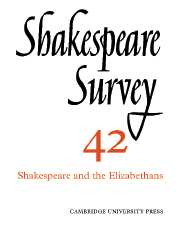Book contents
- Frontmatter
- ‘Jack hath not Jill’: Failed Courtship in Lyly and Shakespeare
- Truth and Art in History Plays
- Chronicles and Mythmaking in Shakespeare’s Joan of Arc
- King John and Embarrassing Women
- Golding’s Ovid, Shakespeare’s ‘Small Latin’, and the Real Object of Mockery in ‘Pyramus and Thisbe’
- Ovid and the Sonnets; or, did Shakespeare Feel the Anxiety of Influence?
- The Play of Sir Thomas More and Some Contemporary Events
- ‘Nobody’s Perfect’: Actors’ Memories and Shakespeare’s Plays of the 1590s
- The Boyhood of Shakespeare’s Heroines
- Shakespeare’s ‘Brawl Ridiculous’
- Shakespeare’s Handwriting
- Shakespeare Performances in England, 1987–8
- Professional Shakespeare Productions in the British Isles, January-December 1987
- The Year's Contributions to Shakespearian Study 1 Critical Studies
- 2 Shakespeare’s Life, Times, and Stage
- 3 Editions and Textual Studies
- Books Received
- Index
Truth and Art in History Plays
Published online by Cambridge University Press: 28 March 2007
- Frontmatter
- ‘Jack hath not Jill’: Failed Courtship in Lyly and Shakespeare
- Truth and Art in History Plays
- Chronicles and Mythmaking in Shakespeare’s Joan of Arc
- King John and Embarrassing Women
- Golding’s Ovid, Shakespeare’s ‘Small Latin’, and the Real Object of Mockery in ‘Pyramus and Thisbe’
- Ovid and the Sonnets; or, did Shakespeare Feel the Anxiety of Influence?
- The Play of Sir Thomas More and Some Contemporary Events
- ‘Nobody’s Perfect’: Actors’ Memories and Shakespeare’s Plays of the 1590s
- The Boyhood of Shakespeare’s Heroines
- Shakespeare’s ‘Brawl Ridiculous’
- Shakespeare’s Handwriting
- Shakespeare Performances in England, 1987–8
- Professional Shakespeare Productions in the British Isles, January-December 1987
- The Year's Contributions to Shakespearian Study 1 Critical Studies
- 2 Shakespeare’s Life, Times, and Stage
- 3 Editions and Textual Studies
- Books Received
- Index
Summary
Since the First Folio says that Shakespeare wrote history plays I think there is a great deal to be said for assuming not only that he did so but did so in the plays thus designated and no others; let evidence precede definition. It is true of course that the evidence available is mixed; Elizabethan generic vocabulary is notoriously spongy: contemporary title pages give us such hybrids as The Tragedy of Richard II, The Tragedy of Richard III, The History of Troilus and Cressida, The True Chronicle History of King Lear, A Pleasant Conceited History called The Taming of a Shrew. The Folio's generic divisions seem to belong, however, to a different mode of discourse: F1 is a company volume, and I have no doubt that its division of plays into Comedies, Histories, and Tragedies reflects company understanding of the repertory, and so, I take it, the understanding of that good company man, William Shakespeare.
Academic critics inevitably prefer definitions to be less blandly empirical, for what space for dazzling reinventions, for pulling rabbits out of hats, not to mention a name in lights, is left available by so preconditioning an acceptance? As professional systematizers we like to be seen to generate our definitions from general principles and our first chapters from titles such as 'What is a history play? Some problems and answers'.
- Type
- Chapter
- Information
- Shakespeare Survey , pp. 15 - 24Publisher: Cambridge University PressPrint publication year: 1990

